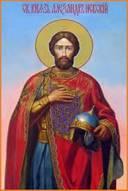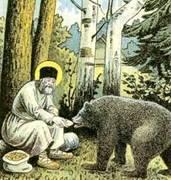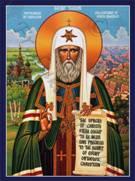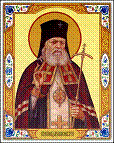Slavic Churches: Church in Russia
WEEK 2: THE CHURCH IN RUSSIA
Each of these sections, divided by importance and presented chronologically, would make a good class presentation; as before, copy beforehand and cut apart, give each student 5 minutes to read his “piece” and present to the class in order, following on the maps the Russian and Mongolian places.
11th and 12th Centuries:
For 200 years after the Baptism of Russia, the people became imbued with Orthodox Christianity. While the country was politically disunited, with constant warfare between princes and assaults of nomadic tribes, the Church was the bond that held the country together. The Patriarch of Constantinople appointed the Metropolitan of Kiev, the head of the Church. The early Metropolitans were spiritual advisors and peacemakers and slowly Christianized the princes and people. They were the “conscience” of the country.
Mongolian Invasion:
In the summer of 1223 a horde of unknown, wild people swept across the country. They were the Mongols, a nomadic people from the plains of Asia who lived on horseback. For the first time they had been united under the fearsome leader, Genghis Khan. They advanced across Russia, destroying every village in their way. Then, without warning, they left.
13 years later, the Mongolians returned. They conquered the country completely and burned and looted the towns and cities. They established a capital city of leather tents in Saraj, where the Volga meets the Caspian Sea. Find it on your maps. They levied heavy taxes and collected ruthlessly.
The Mongolians did allow the Christian Church to continue to hold services. Where their rulers offered no hope or unity, the Church became the one consolation for the Russian people.
St. Alexander Nevsky:
Alexander Nevsky was born in 1219, just before the first Mongolian invasion. He was carefully trained by his father to be a warrior and a statesman, and was taught to read using the Bible as a text. One of his tests was to face a huge brown bear in single combat. But his home was also filled with icons and he attended Divine Liturgy every day.
Alexander was prince of Novgorod when the Mongolians conquered the land in 1237-38. The 18-year-old prince prepared to defend the city by strengthening the walls and digging trenches. But, spring came early that year. The sodden, muddy forests as the snow melted made the Mongolian horsemen helpless and they turned south. Alexander’s city was not invaded!
 Alexander’s Novgorod also faced challenges from the West. Western knights, finished with the crusades, turned east to convert the Eastern Orthodox to their own Roman Catholic Church. After crossing Lithuania, Latvia, and Estonia, Novgorod was the obvious destination. Their attacks were of small scale, looking to take the hearts of the Russian people one village at a time, building medieval castles and imposing Latin services. Alexander’s first victories were against the Knights Templars and their Swedish allies at the river Neva, from which he gets his name Nevsky. He prayed before each battle. In one instance, the sons of Prince Vladimir, Boris and Gleb, were seen in a vision coming to Alexander’s aid.
Alexander’s Novgorod also faced challenges from the West. Western knights, finished with the crusades, turned east to convert the Eastern Orthodox to their own Roman Catholic Church. After crossing Lithuania, Latvia, and Estonia, Novgorod was the obvious destination. Their attacks were of small scale, looking to take the hearts of the Russian people one village at a time, building medieval castles and imposing Latin services. Alexander’s first victories were against the Knights Templars and their Swedish allies at the river Neva, from which he gets his name Nevsky. He prayed before each battle. In one instance, the sons of Prince Vladimir, Boris and Gleb, were seen in a vision coming to Alexander’s aid.
At the death of his father, Alexander inherited the ancient principality of Vladimir. The Khan of the Golden Horde summoned Alexander to his new capital to swear loyalty. What would Alexander do – submit to the Khan? He was the hero of his people; if he defied the Khan, many would follow him in revolt. But, after consulting with Metropolitan Cyril, he chose the way of humility. A revolution would bring only defeat and suffering to Russia. He traveled to Saraj, taking several months on horseback. He was told he must walk thru the purifying fires, a pagan ritual, before reaching the Khan; Alexander refused. Prince Michael of Chernigov had been executed the year before for just such a refusal. But, Alexander met the Khan with such humility and honor, that the Khan allowed him his Christian witness.
The local Khan was so impressed with Alexander that he sent him to Tibet to the Great Khan himself. The journey took 3 ½ years; but, in the end, Alexander Nevsky was named Great Prince of All Russia by the Great Khan himself. The Great Khan promised Alexander that there would be no more bloodshed if the Russian people would only pay their taxes and obey the Mongolian laws. Alexander spent the last 13 years of his life traveling throughout Russia and back and forth to the Khan’s capital, maintaining the tenuous peace and protecting the people of Russia. His letters show clearly that he felt the duties of a Christian prince in governing his people were part of his service to God.
Alexander Nevsky died in 1263 on his way back from yet another visit to the Khan. He was a sick man when he left the Khan and, in a monastery on the way home, Alexander took his vows as a monk on his deathbed. He is remembered to this day by the Russian people as the ideal Christian Prince. He was proclaimed a saint in 1380 for his contribution in safeguarding the Russian Orthodox Church and the Russian people.
By the 15th century, the Mongolians themselves were having internal problems. The Russians began to overthrow them. During this time, Kiev declined in influence and Moscow rose as the political center of Russia. In 1480, Ivan (the Great, or the Terrible?) of Moscow refused to pay taxes and the rule of the Khanate was no more. Moscow became the capital of Russia and their rulers the Czars of all Russia.
Metropolitan to Patriarch:
Throughout the centuries, the metropolitans (bishops of large cities, remember?) of Russia were appointed by the Patriarch of Constantinople. Finally, in 1448, a Council of all the Russian bishops elected Bishop Jonah to be Metropolitan of All Russia. The Russian Church was self-governing. And, in 1589, the Patriarch of Constantinople elevated the status of the Metropolitan of Moscow to that of Patriarch. In fact, after the fall of Constantinople, with the other ancient patriarchates under Turkish rule and Russia freed from the Mongolians, Moscow became for the Orthodox world the 3rd Rome.
The Unia:
After the Mongolian invasion, southwest Russia became a part of Poland. In Southwest Russia – the Ukraine, Galicia, Volynia – Orthodoxy was the religion of a minority in the primarily Roman Catholic Polish state. The Latin rulers first lured the rich nobles to the Roman Church with favors; those who remained Orthodox were discriminated against. Soon Orthodoxy became the religion of the serfs. The bishops had the difficult job of appointing priests that were acceptable to the Latin rulers while approved by the Patriarch of Constantinople.
After a trip to Rome by some of the bishops and a council opposed by the Patriarch, the Unia of Brest-Litovsk was proclaimed. The Orthodox were allowed to keep their Church rituals and married priests but must submit to the authority of the Pope. Those who submitted were called Uniates. Any Orthodox who refused to become Roman Catholic under the Unia were severely persecuted for centuries. Orthodox priests were hunted down with dogs, had their fingers cut off, their feet broken. For almost 20 years, the Church remained without any bishops at all, until several were sent in 1619 by the Patriarch of Constantinople to minister to the Orthodox faithful in southwest Russia.
St. Job of Pochaiev became the guiding light of the Orthodox people in these difficult times. He was born in Galicia in 1550 and lived to be 109 years old. St. Job was not a statesman or politician. He lived a life of asceticism and humble work in a monastery – a symbol of Orthodox piety and a living prayer for his persecuted people.
Finally, when the Polish kingdom fell, the Ukraine fell again under the Orthodox Patriarchate of Moscow. But under the Austro-Hungarian rule, Carpathian and Galician Orthodox were still persecuted. Many became Uniat – today the Byzantine rite of the Roman Catholic Church. Interestingly, many of these Uniat Christians immigrated to the US in the late 1800s. Here they found their Orthodox roots; Father Alexis Toth led one of the first Uniat parishes, St. Mary’s in Minneapolis, back to Orthodoxy in 1890.
Ivan the Terrible to Peter (the Great?):
After the fall of Constantinople, the rulers of Moscow felt themselves to be the Czars (or tsars), heirs to the Byzantine and Roman empires (from the word Caesar). They grew despotic and powerful. From the days when Prince Dmitry sought the advice of St. Sergius and Alexander Nevsky sought the advice of Metropolitan Cyril before any major decision, being the conscience of a Russian czar became a risky business. Metropolitan Philip of Moscow was killed, along with all his friends and relatives, for opposing the bloodshed of Ivan the Terrible in 1568.
This pattern was broken when, after a troubled time of civil war and internal disorder, Michael Romanoff was named czar and his father, Philaret, was named Patriarch. The Patriarch again became the trusted counselor of the czar, almost a co-ruler. This continued under Michael’s son, Alexis. Russia was an Orthodox state and Orthodoxy was a national way of life, including all social customs, for both rich and poor. Millions of people lived in sincere piety.
But the son of Alexis was Peter. Peter had traveled to Europe; Russia seemed old-fashioned and peasant-like to him. Peter had great dreams of changing his country – Westernizing it. He made sudden changes in schooling, dress, speech, furniture, and state administration. But, in many cases, Peter “threw the baby out with the bath water.” Many traditions and pious customs of the past, valued by the so-called “Old Believers,” were upset. Russian society was secularized and education, art, and literature – all once deeply intertwined with the Church – became separate. In Old Russia, the goal of life was to be a good Christian; the new Russia sought industrial development, higher economic standing, and a social life patterned after Western Europe. Peter was afraid that the Patriarch would oppose his reforms. Therefore, when the old Patriarch died, he refused to allow the Church to elect a new Patriarch. In 1721, the Patriarchate was abolished and Peter established the Holy Synod to administer Church affairs. This was the ruling body of the Church for 200 years. Would you call Peter “the Great”? Why or why not?
 In the early 1800s lived one of the most beloved of Russian saints, St. Seraphim of Sarov. He was born Prokhor Moshnin of a family of shopkeepers. A a child, Prokhor became very ill. The Theotokos appeared to him in a dream and promised to heal him; from that time on, his life was devoted to the church. From childhood, Seraphim was modest and unassuming. He became a monk, then deacon, and priestmonk. His life was so godly, that even the animals would come to eat from his hand; he is often pictured with a bear. As a young and vigorous monk, while holding an ax, he was attacked by robbers; he offered no defense and was left for dead. From that day on, his back was hunched. But, his joy was intact! He greeted all with, “My joy; Christ is risen!”He lived an ascetic life of seclusion far in the wilderness, eating and sleeping litttle, yet people came from all over Russia for his wisdom and advice. While he himself lived a life of deep prayer, he did not place heavy burdens on others. For lay people for whom lengthy prayer several times a day was impossible, he developed the Seraphim rule – the Jesus prayer morning until evening while attending to necessary tasks.
In the early 1800s lived one of the most beloved of Russian saints, St. Seraphim of Sarov. He was born Prokhor Moshnin of a family of shopkeepers. A a child, Prokhor became very ill. The Theotokos appeared to him in a dream and promised to heal him; from that time on, his life was devoted to the church. From childhood, Seraphim was modest and unassuming. He became a monk, then deacon, and priestmonk. His life was so godly, that even the animals would come to eat from his hand; he is often pictured with a bear. As a young and vigorous monk, while holding an ax, he was attacked by robbers; he offered no defense and was left for dead. From that day on, his back was hunched. But, his joy was intact! He greeted all with, “My joy; Christ is risen!”He lived an ascetic life of seclusion far in the wilderness, eating and sleeping litttle, yet people came from all over Russia for his wisdom and advice. While he himself lived a life of deep prayer, he did not place heavy burdens on others. For lay people for whom lengthy prayer several times a day was impossible, he developed the Seraphim rule – the Jesus prayer morning until evening while attending to necessary tasks.
 The Russian Revolution:
The Russian Revolution:
In February, 1917 the government of the czar was overthrown and in November the Bolsheviks, or Communists, seized power. In a council during that brief period of temporary government, the Church reinstated the Patriarchate. Chosen as Patriarch was Metropolitan Tikhon of Moscow. Tikhon was a mild and simple man who had been Archbishop of the Russian Orthodox Church in the US for many years. During that time, he was the only Orthodox bishop in North America and traveled extensively to minister to his widely scattered and ethnically diverse flock. He worked hard to give the American church a diocesan and parish structure to help it mature and grow. He returned to Russia in 1907 as Metropolitan of Moscow. Now, in these revolutionary times, Tikhon became the first Patriarch in 200 years. Patriarch Tikhon, knowing the whole central church organization might soon be destroyed, established new rules for local parishes and bishops, giving them the right to govern fully within their spheres. This flexibility would prove essential in the times to come.
The Communists tried to establish a state with no spiritual values at all and violently opposed any religion. No religious education was allowed; atheism was taught in the schools. The Communists arrested priests and executed them. They entered the churches and stole the consecrated objects, then arrested and executed the 1000s of faithful who flocked to protect them. When 50 bishops and priests were brought to public trial, Patriarch Tikhon was brought from prison as a witness. He told the authorities that he alone was to blame – that the priests had only obeyed their God-given leader. The 50 knelt down for his blessing and sang “Christ is Risen” as they were led to their deaths. Under Lenin some 50 bishops were executed, 700 priests were imprisoned or executed. Under Stalin in the 1930s the bloodbath began again. 1937 saw 85% of the clergy of the Russian Orthodox Church imprisoned, exiled to Siberia, or executed. A church has now been built on the site of the Butovo firing range where thousands and thousands were killed. Prior to 1937, there was some semblance of a trial; in 1937 the “conveyor belt” was switched on and dozens could be arrested, tried, and convicted with one complaint. Why this change? Some suggest that the “Great Terror” came about as a result of the realization that, in 1937, two decades after the rise of the atheistic state, more than half of the people were still Orthodox! The goal was no longer the silencing of the church, but its total destruction! Priests and Christians were denounced as enemies of the state, even though most had no political interest at all. About many there are few records and no photographs at all, but a picture emerges of these heroic neo-martyrs. Quickly denounced by others telling lies, they denounced no one and gave no names to their torturers. Baptismal crosses torn off? They had crosses tattooed on their chests. As spoken by Fr. Yakov Noskov to his accusers, “Let it be as it will be. Where can one hide? Let them shoot me, I am not afraid. If I suffer at the hands of the Soviet authorities I will receive a reward from God: paradise.”
Meanwhile, with the Patriarch in prison, the Church had no leader, no head. Odd groups sprang up, urging reform and changing canon law. Tikhon signed an agreement with the Communists appealing to the Christian people to be loyal subjects of the Soviet government. In return, he was released from prison. The “reform” movements died out and the Church was reunited. Patriarch Tikhon died in 1925 on the Feast of the Annunciation. For many decades the exact place of his burial was unknown, but in 1992 it was discovered in the church of the Don Monastery when a fire made renovation of the church necessary.
Many Orthodox escaped the country between 1918 and 1922. The majority settled in Europe. In 1921, Patriarch Tikhon appointed Metropolitan Eulogy as head of the Russian Churches in Western Europe.
After Tikhon came several Metropolitans and Patriarchs. Metropolitan Peter died in prison. Metropolitan Sergius reached a compromise with the Soviets that shocked some Orthodox believers. Many of the exiles in Europe, feeling betrayed, severed ties with Moscow and formed their own Holy Synod or the Russian Orthodox Church Outside Russia -- ROCOR. Metropolitan Alexis continued the attempt to walk the tightrope between effective leadership and martyrdom. He was elected Patriarch in 1942.
The Church Today:
The fall of the Communists nearly 20 years ago, has allowed the Church to enter a period of rebuilding. The faithful have flocked back to the Church. Churches are being rebuilt. Monasteries are being rebuilt. The young are being educated again. While the central government and the economy of Russia exist in a state of near-anarchy, the Church is growing and alive, just as it was in Rome after its times of persecution.
Many of the martyrs and confessors under the Communists have now been named as saints. What is the difference between a martyr and a confessor? A martyr has given his or her life for the Lord; a confessor has suffered persecution but was not put to death. One such saint is  St. Luke of Simferopol and Crimea. He was born in Crimea and trained as a doctor and surgeon. But, he insisted on an icon in his operating room and resisted the Soviet authorities, caring for the poor and teaching the Orthodox faith. After the death of his wife, he was ordained priest and then bishop. Charged falsely with crimes against the government and tried in trumped up courts, the loving bishop and doctor was sent three times in exile to Siberia, separated from his children and developing severe heart problems. The love of the people for this physician bishop was so great that thousands came to his funeral in 1961, risking imprisonment themselves for just being present, and throwing clothing and roses onto the road.
St. Luke of Simferopol and Crimea. He was born in Crimea and trained as a doctor and surgeon. But, he insisted on an icon in his operating room and resisted the Soviet authorities, caring for the poor and teaching the Orthodox faith. After the death of his wife, he was ordained priest and then bishop. Charged falsely with crimes against the government and tried in trumped up courts, the loving bishop and doctor was sent three times in exile to Siberia, separated from his children and developing severe heart problems. The love of the people for this physician bishop was so great that thousands came to his funeral in 1961, risking imprisonment themselves for just being present, and throwing clothing and roses onto the road.
Play a Learning Game: Don’t Make a Move – Write the numbers 1-10 on 10 popsicle sticks. Put them in a pile on the table. Students in turn try to draw a stick without moving the pile. If they succeed, they must answer the question that matches that number. If they cannot answer, the stick goes back in the pile. If successful, the student keeps the stick and keeps going. Student with the most sticks at the end is the winner. Sample questions:
Fill in the blanks:
- The _____________ from the plains of Russia conquered Russian in 1236 AD.
- _______________was the leader of the Mongolians.
- ______________was named Prince of All Russia by the Great Khan.
- The Metropolitan of _________ was elevated to Patriarch just before the fall of Constantinople,
- The agreement whereby Orthodox believers in Latin states could keep their rituals but had to obey the Pope is called the _______.
- ____________________killed Metropolitan Philip of Moscow for opposing his reign of bloodshed.
- _____________ westernized Russia.
- People who clung to their tradition Orthodox piety were called _______________.
- The ruling council of the Orthodox Church established by Peter was called the _____________.
- The Patriarch at the time of the Communist rise to power was ______________.
Primstav: Add St. Alexander Nevsky on November 23, and St. Tikhon on April 7.
Close with Prayer.